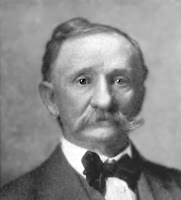| Image may be NSFW. Clik here to view.  |
| Boone statue on College of Idaho campus. |
After high school, he studied at the College of Wooster (Ohio), from which he received A.B. and M.A. degrees. Study at the Western Theological Seminary (Pittsburgh) further prepared him for the ministry (they awarded him a D.D. degree in 1903).
In 1887, Boone took up the Presbyterian ministry in Caldwell, Idaho. Three years later, the Wood River Presbytery founded the private College of Idaho there. Classes began in October 1891 [blog, Oct 7]. Two years later, Boone left his church ministry to assume the presidency of the College, a position he held for the rest of his life.
Initially, Boone taught Latin, Greek, and the natural sciences. In 1902, he was finally able to hire someone else to teach languages. By around 1910, the college could afford professors for all the natural sciences.
However, Dr. Boone’s special expertise, and love, was botany … and he never gave that up. To enrich his teaching, he led students on numerous field expeditions. In the process, he essentially “wrote the book” on the flora of southwest Idaho. His personal garden included a wide variety of plants, including flowers – the “President Boone” rose is named for him.
Dr. Boone passed away in July, 1936. However, his enthusiasm for natural science put a special stamp on the school he founded and led for so long: A liberal arts college with a strong conviction that a fully-educated person must know something about science and its processes.
The school still takes that mission, with its special flavor, very seriously. The core curricula for most smaller liberal arts colleges require just one “hard science” class. Moreover, a substantial minority allows students to fill that requirement with a watered-down, “science survey” class. (A few schools allow students to avoid the subjects altogether.)
College of Idaho requires 7 credit-hours of science, generally meaning that one of the two classes must include a lab. Oddly enough, the College also requires two courses in the “Fine Arts” – music, painting, dance, drama, etc. Most liberal arts schools require only one for their non-majors.
| Image may be NSFW. Clik here to view.  |
| Activities Center, College of Idaho. |
Without apology, the school sees itself as “uncompromisingly Christian,” but welcomes all denominations and leads by strictly voluntary example. Given its small size and community environment, many young people meet their spouses there. Students affectionately referred to the school as “Dr. Boone’s marriage mill.”
As usual for most private liberal arts colleges, College of Idaho has always struggled with finances, yet they have survived. Like any college, success is measured by the achievements of its graduates – and those are outstanding. For Example, H. Corwin Hinshaw, a 1923 graduate, later earned a Ph.D. from UC-Berkeley and pioneered the use of streptomycin to treat tuberculosis.
Today, many graduates have jobs before they leave school and most (98%) are employed within six months after graduation. Moreover, their scholars enjoy a 75% acceptance rate for postgraduate work at many fine institutions.
| References: [French], [Hawley] |
| Louie W. Attebery, The College of Idaho, 1891-1991: A Centennial History. © The College of Idaho, Caldwell (1991). |
| Herbert Harry Hayman, That Man Boone: Frontiersman of Idaho, College of Idaho, Caldwell (1948). |
.jpg)




































